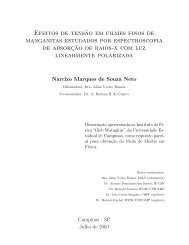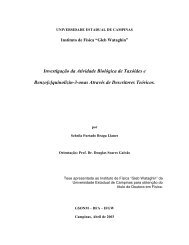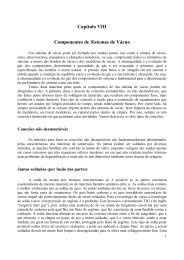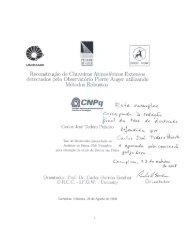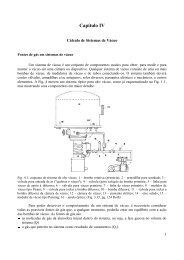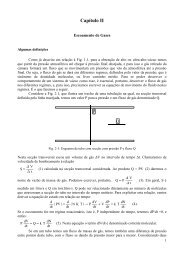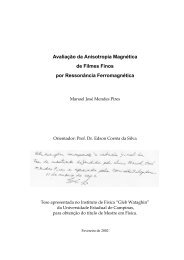Figure 3. Representative s<strong>na</strong>pshots from the molecular dy<strong>na</strong>mics simulations showing the NW time evolution for different crystallographic orientations. See Figure 2 for comparison. The simulation conditions are: (a) 256 (4 × 4 × 16) gold atoms, root-mean-square (rms) t<strong>em</strong>perature 309 K, elongation rate 1 m/s; (b) 240 (4 × 4 × 15) gold atoms, rms t<strong>em</strong>perature 310 K, elongation rate 1.5 m/s; and (c) 400 (5 × 5 × 16) gold atoms, rms t<strong>em</strong>perature 311 K, elongation rate 1 m/s. contact or probably LACs with rather short lifetime (see Figure 3 in Rodrigues et al. 8 ). Several atomistic aspects of the NW formation can be derived from a thorough a<strong>na</strong>lysis of the simulations. For example, there is a large stabilization (∼45 meV/atom) in an initial perfect fcc arrang<strong>em</strong>ent when compared with an imperfect arrang<strong>em</strong>ent, in agre<strong>em</strong>ent with HRTEM observations. 8,23,29 The results pointed out that the formation of stacking faults in the <strong>na</strong>nometric constriction has a critical importance to render LAC formation less difficult. The observed critical importance of layer stacking has never been 35 Figure 4. Representative s<strong>na</strong>pshots sequence showing the time evolution of parallel colum<strong>na</strong>r NW and LAC formation along the [110] orientation. The initial configuration is similar to those shown in Figure 3c1 and contains 1800 atoms (see video 10, Supporting Information). The simulation conditions are: 1800 (10 × 12 × 15) gold atoms, root-mean-square t<strong>em</strong>perature 320 K, elongation rate 2 m/s. addressed before in the literature, and it can explain part of the fluctuations in the experimental <strong>da</strong>ta, where it is not always possible to control the relative crystallographic orientation of NW apexes. Another result is the confirmation of the importance of the slipping planes 4,16 (see video 9, SI) to relieve the tensile stress and decrease the structural disorder. The balance between these two factors controls the formation of LACs. Fi<strong>na</strong>lly, just before breaking, typical mean forces acting on gold atoms forming the LACs are in the range of 0.5-1.5 nN, in excellent agre<strong>em</strong>ent with experimental evidence. 24 Another interesting result from the simulations is that when we increase the aspect ratio of the structures we observed new dy<strong>na</strong>mical features, such as the appearance of parallel colum<strong>na</strong>r NWs (Figure 4). These structures present distinct behavior for the LAC evolution in terms of breaking regions and number of atoms (see video 10, SI). These results are the first theoretical observations of a process proposed by Marquéz and García 36 , where <strong>na</strong>nowires could be formed as a result of multiple filaments or threads stretching. Although in our HRTEM experiments this behavior is unlikely to occur due to the NW fabrication procedures (thinning a bridge between two growing holes), it is a real possibility in mechanically controllable break junction experiments. The presence of such structures could explain the statistical fluctuations that are ever present in conductance <strong>da</strong>ta reported in the literature and deserve further investigation. The low computatio<strong>na</strong>l cost of our methodology has allowed the simulations of a large number (hundreds) of possible configurations at different initial conditions. With this information it was possible to eluci<strong>da</strong>te the relationship between the stochastic <strong>na</strong>ture of the experimental <strong>da</strong>ta and the theoretically derived structural features. The exceptio<strong>na</strong>l agre<strong>em</strong>ent we obtained with the experimental <strong>da</strong>ta reproducing the importance of the different crystallographic directions, 1190 Nano Lett., Vol. 4, No. 7, 2004
NW morphology, forces, stochastic fluctuations, etc., strongly points out that the kinetic aspects during NW elongation are the most important. Our simulations have showed that t<strong>em</strong>perature values and elongation rates strongly affect the morphology and chance of NW formation. The t<strong>em</strong>perature range and elongation rate we used were estimated to be consistent with the available experimental <strong>da</strong>ta. However, to have a better evaluation of the importance of these aspects, more detailed and comparative studies for different metals are necessary. Work along these lines are in progress. Further evidence of the robustness of the present methodology is revealed by the fact that predicted structures for NWs along the [111] axis have been applied to understand the correlation between atomic structure and the experimentally observed conductance behavior. 23 The methodology is completely general and can be used for any metallic fcc structure; it had produced reliable results and can be a very effective tool in the study of MNs and clusters. Work for Ag, Pt, Pd, Cu, Al, Pb, and Ni is in progress. Acknowledgment. The authors thank the Brazilian Agencies CNPq, FAPESP, FAPEMIG, CAPES and Institutos do Milênio de Nanociências e Materiais Poliméricos - MCT. Supporting Information Available: Related slideshow and videos. This material is available free of charge via the Internet at http://pubs.acs.org. References (1) Agraït, N.; Yeyati, A. L.; van Ruitenbeek, J. M. Phys. Rep. 2003, 377, 81. (2) Landman, U.; Luedtke, W. D.; Burnham, N. A.; Colton, R. J. Science 1990, 248, 454. (3) Krans, J. M.; van Ruitenbeek, J. M.; Fisun, V. V.; Yanson, I. K.; de Jongh, L. J. Nature (London) 1995, 375, 767. (4) Landman, U.; Luedtke, W. D.; Salisbury, B. E.; Whetten, R. L. Phys. ReV. Lett. 1996, 77, 1362. (5) Ohnishi, H.; Kondo, Y.; Takaya<strong>na</strong>gi, K. Nature (London) 1998, 395, 780. (6) Yanson, A. I.; Rubio Bollinger, G.; van den Brom, H. E.; Agraït, N.; van Ruitenbeek, J. M. Nature (London) 1998, 395, 783. (7) Sánchez-Portal, D.; Artacho, E.; Junquera, J.; Ordejón, P.; García, A.; Soler, J. M. Phys. ReV. Lett. 1999, 83, 3884. (8) Rodrigues, V.; Fuhrer, T.; Ugarte, D. Phys. ReV. Lett. 2000, 85, 4124. (9) Muller, C. J.; van Ruitenbeek, J. M.; de Jongh, L. J. Physica (Amster<strong>da</strong>m) 1992, 191C, 485. (10) Kondo, Y.; Takaya<strong>na</strong>gi, K. Phys. ReV. Lett. 1997, 79, 3455. (11) Kizuka, T. Phys. ReV. Lett. 1998, 81, 4448. (12) Rodrigues, V.; Ugarte, D. Phys. ReV. B2001, 63, 073405. (13) Kizuka, T.; Umehaa, S.; Fujisawa, S. Jpn. J. Appl. Phys. 2001, 240, L71. (14) Koizumi, H.; Oshima, Y.; Kondo, Y.; Takaya<strong>na</strong>gi, K. Ultramicroscopy 2001, 88, 17. (15) Todorov, T. N.; Sutton, A. P. Phys. ReV. Lett. 1993, 70, 2138. (16) Sorensen, M. R.; Brandbyge M.; Jacobsen, W. Phys. ReV. B1998, 57, 3283. (17) <strong>da</strong> Silva, E. Z.; <strong>da</strong> Silva, A. J. R.; Fazzio, A. Phys. ReV. Lett. 2001, 87, 256102. (18) Kang, J. W.; Hwang, H. J. Nanotechnol. 2002, 13, 503. (19) Stafford, C. A.; Baeriswyl, D.; Bürki, J. Phys. ReV. Lett. 1997, 79, 2863. (20) Yannouleas, C.; Landman, U. J. Phys. Ch<strong>em</strong>. B 1997, 101, 5780. (21) Lang, N. D. Phys. ReV. Lett. 1997, 79, 1357. (22) Wan, C. C.; Mozos, José-Luiz; Taraschi, G.; Wang, J.; Go, H. Appl. Phys. Lett. 1997, 71, 419. (23) Rego, L. G. C.; Rocha, A. R.; Rodrigues, V.; Ugarte, D. Phys. ReV B 2003, 67, 045412. (24) Rubio-Bollinger, G.; Bahn, S. R.; Agraıt, N.; Jacobsen, K. W.; Vieira, S. Phys. ReV. Lett. 2001, 87, 026101. (25) Barnet, R. N.; Landman, U. Nature (London) 1997, 87, 788. (26) Nakamura, A.; Brandbyge, M.; Hansen, L. B.; Jacobsen, K. W. Phys. ReV. Lett. 1999, 82, 1538. (27) Legoas, S. B.; Galvão, D. S.; Rodrigues, V.; Ugarte, D. Phys. ReV. Lett. 2002, 88, 076105. (28) Kruger, D.; Fuchs, H.; Rousseau, R.; Marx, D.; Parrinello, M. Phys. ReV. Lett. 2002, 89, 186402. (29) Rodrigues, V.; Bettini, J.; Rocha, A. R.; Rego, L. G. C.; Ugarte, D. Phys. ReV. B2002, 65, 153402. (30) Cleri, F.; Rosato, V. Phys. ReV. B1993, 48, 22. (31) Tomànek, D.; Aligia, A. A.; Balseiro, C. A. Phys. ReV. B1985, 32, 5051. (32) Ducastelle, F. J. Phys. (Paris) 1970, 31, 1055. (33) Cleri, F.; Mazzone, G.; Rosato, V. Phys. ReV. B1993, 47, 14541. (34) Evangelakis, G. A.; Kallinteris, G. C.; Papanicolaou, N. I. Surf. Sci. 1997, 394, 185. (35) Allen, M. P.; Tildesley, D. J. Computer Simulation of Liquids; Oxford University Press: Oxford, 1996. (36) Correia, A.; Marquéz, M. I.; García,N.InNanowires; Sere<strong>na</strong>, P. A., García, N., Eds.; NATO ASI Series, Series E: Applied Sciences; Kluwer Acad<strong>em</strong>ic Publishers: The Netherlands, 1997; Vol. 340, pp 311-325. NL049725H 36 Nano Lett., Vol. 4, No. 7, 2004 1191
- Page 2 and 3: FICHA CATALOGRÁFICA ELABORADA PELA
- Page 4 and 5: Agradecimentos Agradeço aos profes
- Page 6 and 7: Resumo Neste trabalho utilizamos m
- Page 8 and 9: Sumário 1 Introdução 3 2 Metodol
- Page 10 and 11: Capítulo 1 Introdução “O come
- Page 12 and 13: comportamento do alongamento de uma
- Page 14 and 15: de sistemas com muitos átomos, por
- Page 16 and 17: Em um sistema molecular dizemos que
- Page 18 and 19: Os algoritmos de Verlet são os mai
- Page 20 and 21: • r αβ 0 representa a distânci
- Page 22 and 23: são resolvidos condicionalmente a
- Page 24 and 25: alongamento do cluster na simulaç
- Page 26 and 27: Figura 2.2: Esquema de configuraç
- Page 28 and 29: valores esperados em termos de ˆT
- Page 30 and 31: 2.18. Os orbitais atômicos χ µ s
- Page 32 and 33: Capítulo 3 Introdução - Nanofios
- Page 34 and 35: Figura 3.1: Esquema da formação d
- Page 36 and 37: Capítulo 4 Nanofios de Ouro (Au) M
- Page 38 and 39: 4.1 Conclusões Para fazer uma desc
- Page 40 and 41: Figure 1. HRTEM images of [100] gol
- Page 44 and 45: Capítulo 5 Nanofios de Cobre (Cu)
- Page 46 and 47: PHYSICAL REVIEW B 74, 193401 2006 T
- Page 48 and 49: BRIEF REPORTS PHYSICAL REVIEW B 74,
- Page 50 and 51: 5.2 Motivos Pentagonais em NanoFios
- Page 52 and 53: VOLUME 93, NUMBER 12 PHYSICAL REVIE
- Page 54 and 55: VOLUME 93, NUMBER 12 PHYSICAL REVIE
- Page 56 and 57: 5.3 Conclusões A formulação do n
- Page 58 and 59: Espécie Direção Características
- Page 60 and 61: transmissão ou por dados eletrôni
- Page 62 and 63: LETTERS a b 0.8 Frozen layers 0.75
- Page 64 and 65: LETTERS self-supported metal film b
- Page 66 and 67: Figura 7.1: Representação da cade
- Page 68 and 69: Figura 7.3: Energia em função da
- Page 70 and 71: Figura 7.5: Seqüência da simulaç
- Page 72 and 73: Figura 7.7: (a) Comprimento de liga
- Page 74 and 75: Figura 7.10: Distância entre átom
- Page 76 and 77: Figura 7.18: Distância entre átom
- Page 78 and 79: Capítulo 8 De onde vem os átomos
- Page 80 and 81: 1528 Applied Physics A - Materials
- Page 82 and 83: 1530 Applied Physics A - Materials
- Page 84 and 85: Na mesma linha do estudo anterior,
- Page 86 and 87: Figura 8.2: Contagem dos átomos da
- Page 88 and 89: Au(500) Au(1000) Ag(500) Ag(1000) C
- Page 90 and 91: Figura 8.3: Contagem dos átomos da
- Page 92 and 93:
Figura 8.5: Contagem dos átomos da
- Page 94 and 95:
Figura 8.7: Contagem dos átomos da
- Page 96 and 97:
Figura 9.1: a-f) Imagens da seqüê
- Page 98 and 99:
Posição Número Pt Pt Ag Au do Tw
- Page 100 and 101:
PRL 99, 255501 (2007) PHYSICAL REVI
- Page 102 and 103:
PRL 99, 255501 (2007) PHYSICAL REVI
- Page 104 and 105:
Capítulo 11 Molécula de Lander A
- Page 106 and 107:
em contato com a superfície. Neste
- Page 108 and 109:
eram difusões, para os casos da VL
- Page 110 and 111:
Figura 11.7: Energia Potencial do m
- Page 112 and 113:
LETTERS Lock-and-key effect in the
- Page 114 and 115:
LETTERS a [110] - [110] t = 0.01 ps
- Page 116 and 117:
Capítulo 12 Perspectivas Nesta tes
- Page 118 and 119:
[14] T. Kizuka, S. Umehaa, and S. F
- Page 120 and 121:
[50] M. J. Frisch and et al. Gaussi
- Page 122 and 123:
Lista de Figuras 2.1 Típico cluste
- Page 124 and 125:
7.17 Distância entre átomos da ca
- Page 126:
Lista de Tabelas 2.1 Parâmetros do



